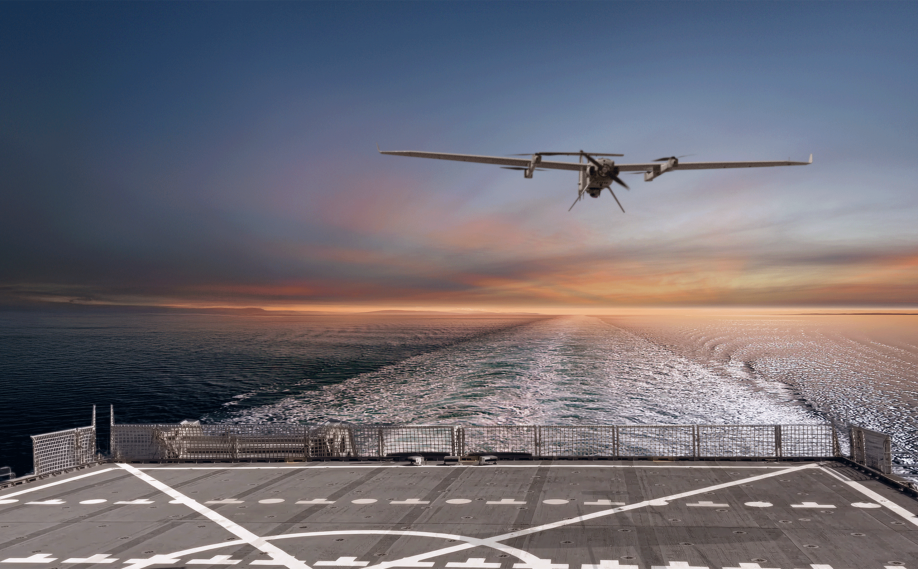IDEX 2025: AeroVironment launches JUMP 20-X UAS
AeroVironment announced the launch of its JUMP 20-X uncrewed aerial system (UAS) during the IDEX 2025 exhibition in Abu Dhabi, which was held from February 17th to the 21st.
The company described the JUMP 20-X as a next-generation modular Group 3 UAS with vertical take-off and landing (VTOL) capabilities that is designed for shipboard UAS operations.
It is geared towards an ISR capability with a beyond-line-of-site communication range of 185 km and a flight endurance of over 13 hours. The VTOL capability is designed to ensure that the UAS can be launched from a ship without the need for a runway.
Shane Hastings, vice president and general manager of medium uncrewed aircraft systems at AeroVironment, stated that the “JUMP 20-X redefines what’s possible for maritime and expeditionary UAS operations in the most contested domains”.
Take-off and landing for the JUMP 20-X is empowered by artificial intelligence providing autonomy over those functions. The endurance and autonomy are central to how the system redefines maritime UAS operations, according to Hastings.
The design appears to build on the original JUMP 20, which was selected by Denmark on the 10th February 2025 under a ten year programme with a funding ceiling of $181 million. The additional capabilities for sensing and landing at sea, appear to be the primary differentiators between the two systems, as well as the JUMP-X being fully marinised and designed to withstand conditions at sea.
The UAS is currently going through its final stages of testing, an AeroVironment representative told a trade news outlet, indicating that it would be up for sale in the next few months.
Tech profile: JUMP 20-X

The JUMP 20-X is a marinised version of the JUMP 20 with capabilities designed for maritime surveillance. Credit: AeroVironment
The JUMP 20-X has a wingspan of 5.7m, a length of 2.9m, and a maximum gross take-off weight of 97.5kg (including fuel and payload). It is powered by a 230cc heavy fuel engine providing a cruise speed of 93 km/h with an operational altitude of 17,000ft. The UAS utilises a command/control interface with a plug-in architecture called Vigilant Spirit, which the USAF Research Laboratory developed. Vigilant Spirit is STANAG 4586 compliant, a standardisation agreement for UAVs that ensures they are reaching the required level of interoperability for NATO forces.
Perhaps, most importantly for this type of UAS, it can use its 13 kg payload to carry an array of sensor technologies including electro-optical and infrared cameras, radars, and signals intelligence systems. IMSAR developed the NSP-3 tactical multi-intelligence SAR (synthetic aperture radar), MTI (moving target indicator), and CCD (coherent change detection) radars which had been integrated onto the JUMP 20. The radars reportedly enable a UAS to detect and track a small craft at a range of 10 km, increasing to 80 km for a super tanker. These may be the systems used on the JUMP 20-X.
The UAS can also carry munitions like the Shryke munition, developed by L3Harris and Corvid Technology. Additional payload options include the Hatchet precision strike munition developed by Northrop Grumman; which has 45-80% of the lethality of a 225 kg class weapon, according to Northrop.
Calibre Comment
Many nations view the development and use of autonomous platforms at sea as a priority area. One example is the development of Turkey’s amphibious drone carrier, the TCG Anadolu, which can launch UCAVs from its short-runway platform. The US Navy is also working to understand how to deploy and integrate UAS from its aircraft carriers. They provide the reach and mass needed to patrol and control large areas of sea like the Pacific. However, notable criticisms of UAS include the ability of air defence systems and electronic warfare capabilities to limit their operational effectiveness.
By Austin Haywood, published on 20th February 2025.

Sign Up for Updates!
Get insider news, tips, and updates. No spam, just the good stuff!





